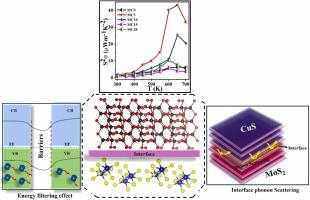Enhanced Acoustic Phonon Scattering via engineering the Interface in MoS₂/CuS Nanocomposites for Ultra-Low Thermal Conductivity
IF 6.3
2区 材料科学
Q2 CHEMISTRY, PHYSICAL
引用次数: 0
Abstract
Significant advancements in power factor are widely realized in bulk thermoelectric materials through strategies such as doping, band engineering, and nanostructuring. We report the first demonstration of simultaneous enhancement of the Seebeck coefficient and electrical conductivity in p-type MoS₂/CuS nanocomposites through precise compositional tuning that activates a strong energy filtering effect. Leveraging the phonon liquid electron crystal (PLEC) nature of CuS, our approach delivers synergistic optimization of charge and phonon transport. The optimized 20 wt% CuS composite achieves a high electrical conductivity of 893 Scm-1 and a power factor of 41 μWm-1K-2 at 653 K, attributed to increased Cu2+ ion concentration and a high density of states near the Fermi level (~0.2 eV) enabled by band structure modulation. At the same temperature, the material also exhibits an ultra-low thermal conductivity of 0.2 Wm-1K-1 due to intensified acoustic and interfacial phonon scattering. This synergistic control of electronic and thermal transport represents a novel strategy for mid-temperature thermoelectric materials design, positioning MoS₂/CuS nanocomposites as promising candidates for next-generation power generation systems.

超低导热MoS 2 / cu纳米复合材料界面工程增强声子散射
通过掺杂、能带工程和纳米结构等策略,在块状热电材料中广泛实现了功率因数的显著进步。我们首次报道了通过精确的成分调谐激活强大的能量过滤效应,p型MoS 2 / cu纳米复合材料中的塞贝克系数和电导率同时增强的演示。利用CuS的声子液体电子晶体(PLEC)特性,我们的方法实现了电荷和声子输运的协同优化。优化后的20 wt% cu复合材料在653 K时获得了893 μ wm -1的高电导率和41 μWm-1K-2的功率因数,这主要归功于带结构调制提高了Cu2+离子浓度和在费米能级(~0.2 eV)附近的高密度态。在相同温度下,由于声散射和界面声子散射加剧,材料的导热系数为0.2 Wm-1K-1。这种电子和热输运的协同控制代表了中温热电材料设计的一种新策略,将MoS₂/ cu纳米复合材料定位为下一代发电系统的有前途的候选者。
本文章由计算机程序翻译,如有差异,请以英文原文为准。
求助全文
约1分钟内获得全文
求助全文
来源期刊

Journal of Alloys and Compounds
工程技术-材料科学:综合
CiteScore
11.10
自引率
14.50%
发文量
5146
审稿时长
67 days
期刊介绍:
The Journal of Alloys and Compounds is intended to serve as an international medium for the publication of work on solid materials comprising compounds as well as alloys. Its great strength lies in the diversity of discipline which it encompasses, drawing together results from materials science, solid-state chemistry and physics.
 求助内容:
求助内容: 应助结果提醒方式:
应助结果提醒方式:


